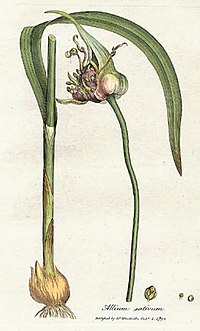
Photo from wikipedia
ETHNOPHARMACOLOGICAL RELEVANCE For thousands of years, garlic (Allium sativum Linnaeus) has been consumed in food and health by numerous civilizations. Cryptosporidium (C.) parvum is an apicomplexan parasite that causes a… Click to show full abstract
ETHNOPHARMACOLOGICAL RELEVANCE For thousands of years, garlic (Allium sativum Linnaeus) has been consumed in food and health by numerous civilizations. Cryptosporidium (C.) parvum is an apicomplexan parasite that causes a gastrointestinal disease, with the most common symptoms being watery diarrhea. Although several substances have been tried for its anti-cryptosporidial action, there is no effective treatment for Cryptosporidium disease, especially in immunocompromised individuals. The present study aimed firstly to characterize the bio-active compounds in Allium sativum L. and secondly to evaluate its efficacy as a therapy for cryptosporidiosis especially in immunocompromised mice. MATERIALS AND METHODS This was accomplished by evaluating the parasitological and histopathological parameters in the experimentally infected immunocompetent and immunocompromised mice. Also, the cytokine profile during the experimental time was recorded through the measuring of T helper (h)1, Th2 and Th17 cells cytokines. Immunosuppressed mice were given 0.25 μg/g per day of dexamethasone orally, before infection with Cryptosporidium parvum oocysts, for fourteen consecutive days. Starting 10 days post infection (PI), nitazoxanide (100 mg/kg per day) or Allium sativum (50 mg/kg per day) was given orally for fourteen consecutive days. RESULTS Our results showed that oocyst shedding, on the 32nd day PI, in immunocompromised infected group treated with Allium sativum (354.11, 99.35% PR) showed a significant decrease when compared to its corresponding group treated with nitazoxanide (4369.14, 92.05% PR). On the 32nd day PI, all cytokines levels have been decreased to levels that were similar to those of their uninfected corresponding control groups; also, the histopathological changes and the loss in animals' body weight had been improved. Treatment with nitazoxanide did not result in infection clearance or a reduction in the increased cytokines' levels. CONCLUSION Allium sativum L. displayed high efficacy as a potential therapeutic agent against Cryptosporidium, which supports its traditional usage in parasite diseases.
Journal Title: Journal of ethnopharmacology
Year Published: 2022
Link to full text (if available)
Share on Social Media: Sign Up to like & get
recommendations!